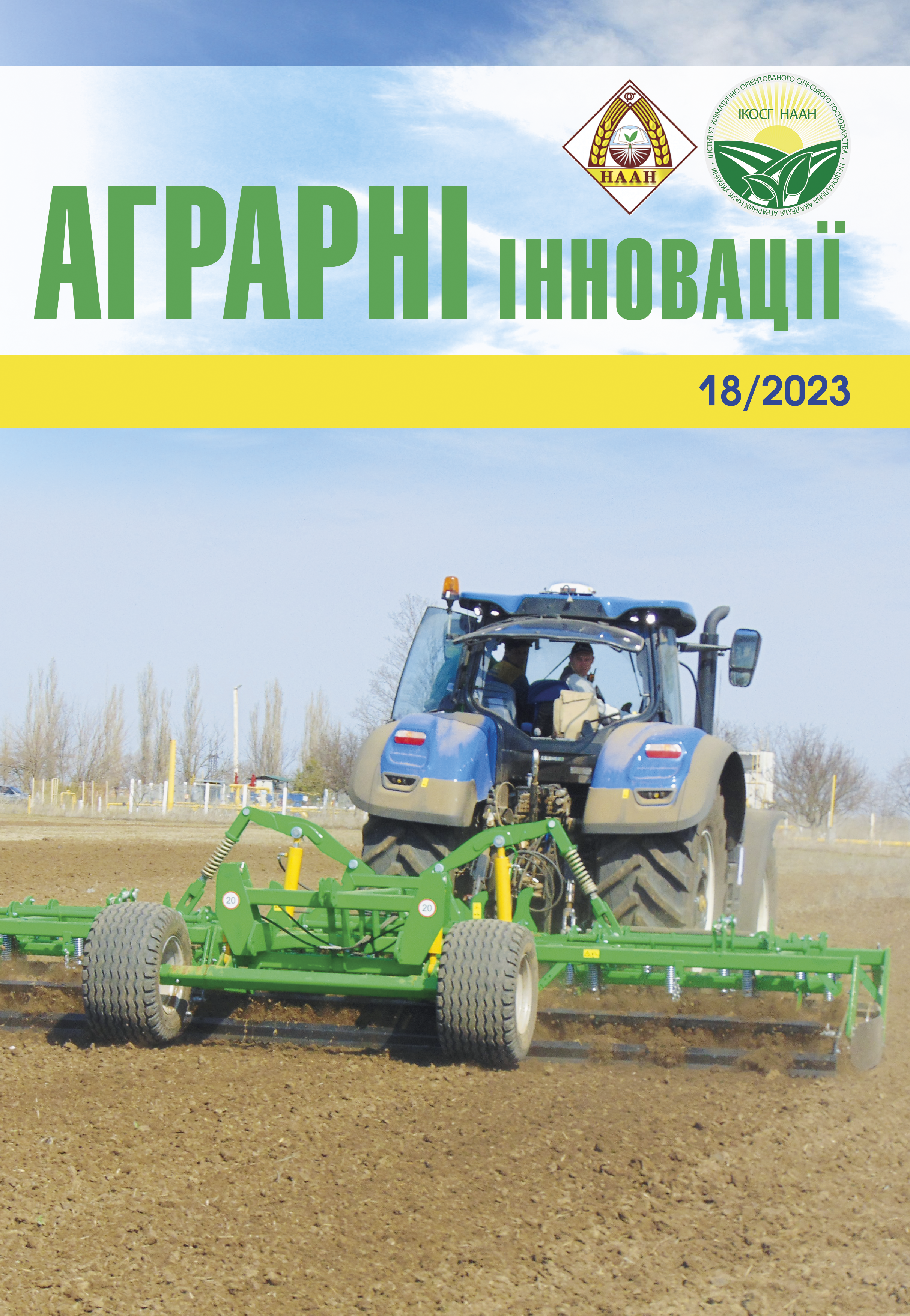GREENHOUSE GAS BALANCE IN ORGANIC SOYBEAN CULTIVATION DEPENDING ON SOIL TILLAGE SYSTEMS
Abstract
Purpose. Agricultural activities are one of the main sources of greenhouse gas (GHG) emissions. Soil tillage has been identified as one of the significant sources of GHG emissions in the agricultural sector. The aim of the study was to determine and compare the amount of GHG emissions under traditional, reduced, and no-till soil tillage systems in organic soybean cultivation. Methods. The study used data from a field experiment that examined the effectiveness of soil tillage systems (traditional, reduced, and no-till) and their impact on carbon emissions and sequestration in organic soybean cultivation. GHG emissions calculations were performed using the empirical calculations methodology based on the Cool Farm Tool online calculator, which is based on internationally recognized standards for GHG accounting, such as the Greenhouse Gas Protocol for Agriculture (GHG Protocol) and the Intergovernmental Panel on Climate Change (IPCC) Guidelines for National Greenhouse Gas Inventories. Results. The research showed that the traditional soil tillage system significantly increased GHG emissions, which reached 1040 kg/ha CO2-eq, while the implementation of reduced and no-till soil tillage systems contributed to carbon sequestration in the soil and reduced GHG emissions by 22 and 241 kg/ha CO2-eq, respectively. Findings. This study justifies the optimal choice of soil tillage systems in organic soybean cultivation as an important element of carbon agriculture, which is associated with mitigating the impact of agriculture on climate change. Based on the results of the research and calculations, it can be said that using reduced and no-till soil tillage systems under the conditions of the Forest-Steppe of Ukraine can result in an organic soybean harvest with zero carbon footprint, which is promising for the export-oriented nature of this crop.
References
2. Blanco-Canqui H., Lal R., Owens L. B. Soil tillage and crop sequence impacts on carbon sequestration and soil aggregation in a Mollisol. Soil science society of america journal. 2015. Т. 79, № 3. С. 811–818.
3. Carbon farming. Climate Action. URL: https://ec.europa. eu/clima/eu-action/forests-and-agriculture/sustainablecarbon- cycles/carbon-farming_en (дата звернення: 22.03.2023).
4. Log in – cool farm tool. Log in – Cool Farm Tool. URL: https://app.coolfarmtool.org/ (дата звернення: 25.03.2023).
5. Tillage-induced CO2 emission from soil – Nutrient Cycling in Agroecosystems. SpringerLink. URL: h t t p s : / / l i n k . s p r i n g e r. c o m / a r t i c l e / 1 0 . 1 0 2 3 / A : 1009766510274 (дата звернення: 24.03.2023).
6. Guo L. B., Gifford R. M. Soil carbon stocks and land use change: a meta analysis. Global change biology. 2002. Т . 8 , № 4. С. 345–360. URL: https://doi.org/10.1046/j.1354-1013.2002.00486.x (дата звернення: 23.03.2023).
7. Effects of tillage practices on greenhouse gas emissions in dryland agriculture: a review / Guo, L та ін. Journal of arid land. 2018. Т. 10, № 6. С. 775–788.
8. Quality and dynamics of soil organic matter in a typical Chernozem of Ukraine under different long-term tillage systems / Y. Kravchenko та ін. Canadian journal of soil science. 2012. Т. 9 2, № 3. С. 429–438. URL: https://doi.org/10.4141/cjss2010-053 (дата звернення: 21.03.2023).
9. Greenhouse gases emissions from ukrainian soils under different tillage systems. / Kuzmenko, Y та ін. Visnyk of dnipropetrovsk university. biology, ecology. 2018. Т. 26, № 1. С. 47–54.
10. Lal R. Soil carbon sequestration impacts on global climate change and food security. Science. 2004. Т. 304, № 5677. С. 1623–1627. URL: https://doi.org/10.1126/ science.1097396 (дата звернення: 21.03.2023).
11. Martynov, V, Tokhtar, V, Yermolenko, N. Greenhouse gas emissions from ukrainian soils under different tillage systems. Journal of water and land development. 2018. Т. 37. С. 133–141.
12. Influence of tillage systems on greenhouse gas emissions in soil. / Romanenko, O та ін. Agrology. 2019. Т. 2, № 1. С. 47–54.
13. Greenhouse gas mitigation in agriculture / P. Smith та ін. Philosophical transactions of the royal society B: biological sciences. 2007. Т. 363, № 1492. С. 789–813. URL: https://doi.org/10.1098/rstb.2007.2184 (дата звернення: 21.03.2023)
14. Soteriades, A. D, Jones, R. J. Greenhouse gas mitigation strategies in the agricultural sector using the cool farm tool. Journal of cleaner production. 2018. Т. 196. С. 171–178.
15. State Agency of Ukraine for Environmental Protection. Greenhouse Gas Inventory in Ukraine. URL: http://ghginventory. emenr.gov.ua/ (дата звернення: 20.03.2023).
16. World bank open data. World Bank Open Data. URL: https://data.worldbank.org/country/ukraine (дата звернення: 22.03.2023).
17. Effects of tillage practices on nitrous oxide emissions in agricultural soils: a meta-analysis. / Xu, H та ін. Journal of environmental management. 2018. Т. 207. С. 362–370.
18. Боровиков В, Попова О. Вплив агротехнологій на викиди парникових газів з ґрунту. Науковий вісник НУБіП України. 2020. Т. 5, № 92.
19. Україна виконала міжнародні зобов’язання щодо запобігання зміни клімату на початок 2022 року – Рахункова палата. Рахункова палата. URL: http://rp.gov.ua/PressCenter/News/?id=1406 (дата звернення: 20.03.2023).






